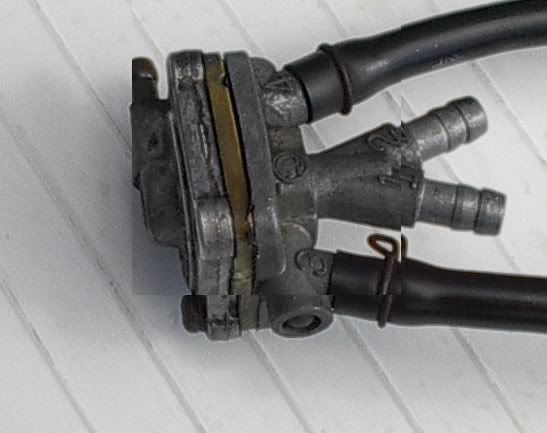Octopus revelation!
For anyone who has had octopus problems, or just gave up and bypassed them, check this!
For months, maybe years, I struggled with fuel leaks from my SG Special, especially when parked. I replaced the float needles with spares (not new) which mitigated the leaks somewhat, but never completely eliminated them. So, I just got in the habit of turning the petcocks to “OFF” and lived with it. I know I need new needles, and I will get them when I know what else I need to fill out my order (from PNM).
A couple years ago, I had suspected a problem with the octopus, and dismantled it for inspection. Everything looked good, clean as a whistle, no holes or tears in the diaphragm membranes, and the piston and o-ring were perfect. The diaphragm opened and shut properly with vacuum, and it held the vacuum. So I dismissed that as a cause of my leaks.
Lately, the leaking had become worse. So I pulled everything apart (noticing that there was a couple ounces of fuel in the air box). Before I pulled off the carbs to replace needles, I decided to check the lines (all fine) and octopus one more time. Per the Clymer’s manual test, I hooked the inner lines of the octopus to the rear nipple on each petcock. Then I removed the front fuel lines, turned the right petcock “ON”, and fuel flowed from the other petcock. What the ???
So, I reasoned there must be a problem with the membranes even though they looked fine, and seemed to work properly.
I have a spare octopus from a set of carbs I bought off E-bay couple years ago, so I hooked up the spare, crusty, cruddy octopus. It worked fine - no fuel flowed until vacuum was applied.
Puzzled, I closely examined both octopi. They looked identical, (except for the crud and rust on the spare) until I noticed one VERY small difference. There is a tiny vent channel in the plastic diaphragm block, between the membrane and block, on the hose side of the assembly. It is barely visible in the picture, at the top of the block, by the top fuel hose.
I noticed that on the spare, which worked fine, this vent was facing down, toward the mounting bracket. But on my original, I must have reinstalled this “sandwich” of block and membranes with that vent pointing upwards, 180 degrees off. I couldn’t imagine it would make any difference but, nonetheless, I reassemble the original octopus with that vent facing down, I tested it again. It tested fine, and there are NO LEAKS! It’s been parked over a week, with petcocks turned “ON”, and not a drop has leaked from the carbs, lines or octopus!
I still can’t comprehend why it makes difference, but it does! Any ideas why?

For anyone who has had octopus problems, or just gave up and bypassed them, check this!
For months, maybe years, I struggled with fuel leaks from my SG Special, especially when parked. I replaced the float needles with spares (not new) which mitigated the leaks somewhat, but never completely eliminated them. So, I just got in the habit of turning the petcocks to “OFF” and lived with it. I know I need new needles, and I will get them when I know what else I need to fill out my order (from PNM).
A couple years ago, I had suspected a problem with the octopus, and dismantled it for inspection. Everything looked good, clean as a whistle, no holes or tears in the diaphragm membranes, and the piston and o-ring were perfect. The diaphragm opened and shut properly with vacuum, and it held the vacuum. So I dismissed that as a cause of my leaks.
Lately, the leaking had become worse. So I pulled everything apart (noticing that there was a couple ounces of fuel in the air box). Before I pulled off the carbs to replace needles, I decided to check the lines (all fine) and octopus one more time. Per the Clymer’s manual test, I hooked the inner lines of the octopus to the rear nipple on each petcock. Then I removed the front fuel lines, turned the right petcock “ON”, and fuel flowed from the other petcock. What the ???
So, I reasoned there must be a problem with the membranes even though they looked fine, and seemed to work properly.
I have a spare octopus from a set of carbs I bought off E-bay couple years ago, so I hooked up the spare, crusty, cruddy octopus. It worked fine - no fuel flowed until vacuum was applied.
Puzzled, I closely examined both octopi. They looked identical, (except for the crud and rust on the spare) until I noticed one VERY small difference. There is a tiny vent channel in the plastic diaphragm block, between the membrane and block, on the hose side of the assembly. It is barely visible in the picture, at the top of the block, by the top fuel hose.
I noticed that on the spare, which worked fine, this vent was facing down, toward the mounting bracket. But on my original, I must have reinstalled this “sandwich” of block and membranes with that vent pointing upwards, 180 degrees off. I couldn’t imagine it would make any difference but, nonetheless, I reassemble the original octopus with that vent facing down, I tested it again. It tested fine, and there are NO LEAKS! It’s been parked over a week, with petcocks turned “ON”, and not a drop has leaked from the carbs, lines or octopus!
I still can’t comprehend why it makes difference, but it does! Any ideas why?

Comment